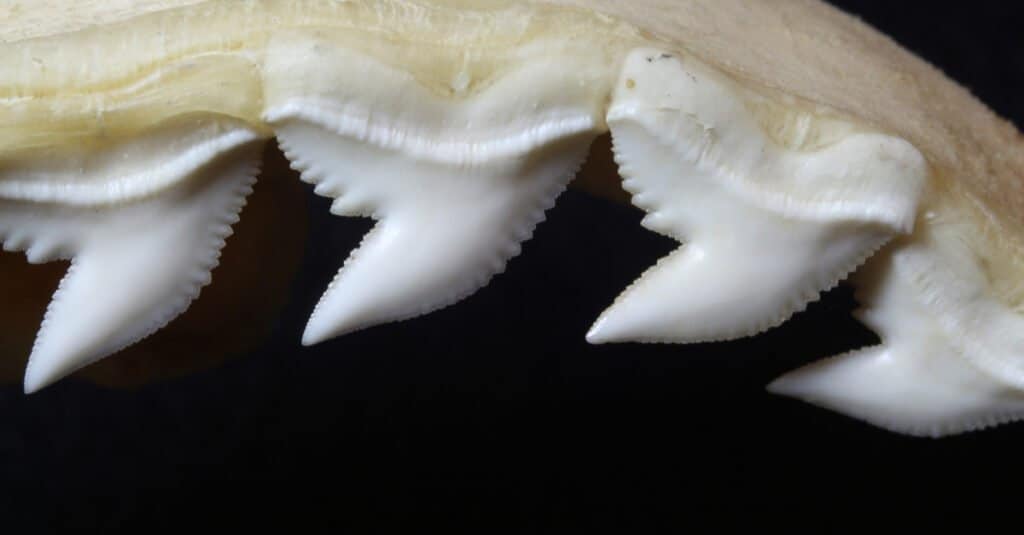When you think about the word “shark”, you might immediately think of one uniform appearance that belongs to great white sharks. There are, however, many species of sharks in the ocean, with different body length and weight, and various physical characteristics. The tiger shark, for instance, got its name from its vertical stripes covering the side of its body, much like that of a tiger. These vertical bars are often noticeable during their juvenile stage, and usually fade overtime or as tiger sharks reach adulthood.
The tiger shark is the second-largest predatory shark in the world, after the great white shark, with a maximum length of 18 feet and a maximum weight of about a ton.
Being at the top of the food chain, like most shark species, tiger sharks are quite aggressive, and can eat just anything that comes in their way that is small enough for them to capture. As slow-moving fish, they favor prey that are easy to catch through ambush predation, stalking and then grabbing their prey as a primary hunting stunt. That being said, it may be obvious as well that these fish have sharp and strong teeth that enable them to catch and kill prey effortlessly.
How Many Teeth Do Tiger Sharks Have?

Tiger sharks have about 48 teeth which allow them to cut and grip onto prey.
©Matthew R McClure/Shutterstock.com
Tiger sharks have 48 identical teeth located in rows at the upper and lower jaws. Unlike mammalian predators who have different sets of teeth that function differently in eating their food, sharks have all their teeth in the same appearance.
Most sharks who pursue swimming prey have an upper jaw that is built to pierce through prey’s flesh, and a lower jaw designed to grip and hold the prey in place. Unlike these types of sharks, all of tiger sharks’ 24 upper and lower teeth are identical, both in the upper and lower jaws. This allows tiger sharks to cut and grip onto prey using both jaws. Both a cutting and a sawing area can be found on a tiger shark’s set of teeth.
What Do Tiger Shark Teeth Look Like?
The teeth of tiger sharks are distinctive in appearance, being short, broad, and seemingly strong. Serrations decorate the razor-sharp blades which help tiger sharks pierce through clams and shells.
The teeth of tiger sharks can easily be recognized by their slant tip and sharp serrations. Even turtle shells are no match for their razor-sharp teeth, which can cut through bone, flesh, and even the shells of other animals. Like most shark species, throughout its life, the tiger shark continuously sheds and replenishes these teeth.
Tiger sharks have a larger mouth than other members of the Carcharhinidae family. Slender serrations and pointed edges protrude from the sides of each tooth, which is identical in shape to the other teeth. Their teeth can also be used as a saw since they have a saw-like area inside their mouth.
How Strong is a Tiger Shark’s Bite?

Tiger sharks can have a bite pressure of more than 6,000 pounds per square centimeter.
©Ryan M. Bolton/Shutterstock.com
What distinguishes the tiger shark from the majority of shark species is its teeth and jaws. Tiger sharks have a bite pressure of 6,000 pounds per square centimeter or more. The tiger shark teeth also feature a special portion which is a flatter, rear tooth component that shields the saw’s vast cutting area from the shark’s enormous bite pressure.
How Do Tiger Shark Teeth Work?
A tiger shark’s set of identical teeth have two functions in one: grabbing and gripping onto struggling prey and cutting and tearing just any type of thick skin, making their menu of food even wider.
A tiger shark’s jaws would open out to reveal teeth with striking notch tips that point in the opposite direction. Both the teeth on the right and left halves of the jaw look like mirror reflections of each other, as well. In addition to their ability to pierce through the toughest of skin, tiger sharks’ teeth also aid in the fish’s ability to hold on to their prey while they’re fighting for their lives.
Also, unlike other sharks, the jaws of tiger sharks are square in shape rather than circular. In the middle of the tiger shark’s snout, the cartilage of the jaw meets at a nearly perfect angle, giving this shark its distinctive look.
As sharks who are known to regularly hunt sea turtles, they need their dental structure to be strong and sharp enough to cut through these creatures’ shells.
How Long are Tiger Shark Teeth?

A tiger shark’s teeth can grow as long as 2 inches.
©Tomas Kotouc/Shutterstock.com
A tiger shark’s teeth usually range around 1 inch in length, but can sometimes grow as long as 1.5 to 2 inches. The short yet notched teeth of tiger sharks make them unique from other shark species, and is actually one of the most defining features of a tiger shark. The shoulders of a tiger shark’s teeth that have sharp, jagged edges also help them crush clams, and even shells of many sea turtles.
With the ability to grow an average of 10-14 feet long, the tiger shark can weigh up to 850-1,400 pounds. The largest female tiger shark ever recorded weighed 1,780 pounds but its believed tiger sharks that haven’t “officially” been weighed have grown to even larger sizes! Great white sharks can grow to be a few feet longer than tiger sharks and the largest great white on record weighs an estimated 5,000 pounds!
Do Tiger Sharks Bite Humans?
Despite the fact that sharks rarely attack humans, the tiger shark is one of the most dangerous and has been implicated in many fatalities caused by tiger shark bites. It’s not uncommon for them to venture into shallow waters such as harbors and canals, where they may come into contact with humans.
There is no greater predator than a great white when it comes to attacking humans, but tiger sharks have even earned themselves a reputation as man-eaters too, and they come in second to these humongous sea creatures when it comes to human attacks. However, keep in mind that while shark attacks happen, in any given year sharks kill less than 1/1,000th the humans that snakes do. That is to say, you shouldn’t lose any sleep over a shark attack.
The photo featured at the top of this post is © Matthew R McClure/Shutterstock.com
Thank you for reading! Have some feedback for us? Contact the AZ Animals editorial team.






